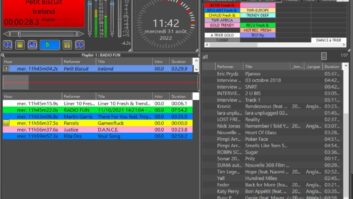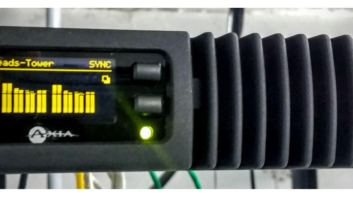Photos
(click thumbnail)Fig. 1: View from the road of the tower and tilted ATU
(click thumbnail)Fig. 2: A toppled AM tuning box
(click thumbnail)Fig. 3: The mid-array stream, where the problem developed
(click thumbnail)Fig. 4: Tension on the above-ground lines pulled at the ATU
(click thumbnail)Fig. 5: Even with a toppled ATU, the antenna is still being fed!
While traveling by car, Cumulus Youngstown Market Engineer Wes Boyd spotted a peculiar AM site. From the side of the road, pictured in Fig. 1, it looked as though one tower’s tuning box was falling over. Wes got out of his car and did a little investigating. Fig. 2 shows the toppled tuning box as he approached.
In the middle of the array, and seen in Fig. 3, Wes noted a small stream that had collected debris that was tangled in the transmission lines. The combination of the moving water and a “beaver dam” collection of logs, branches and debris had pulled the overhead-fed transmission lines about 25 feet.
It was this tension on the transmission, electric and sample lines shown in Fig. 4, that caused the tuning boxes and portions of the fences around towers on each side of the stream to suffer damage. The tension of these lines connected to the coupling networks actually toppled the tuning boxes!
What’s amazing is that in Fig. 5, even with the coupling network toppled, the ATU output tubing, running from the coupling network to the tower, was still intact — and the station remained on the air!
For how long, now that’s another question.
Wes’ photo essay is another reason you want to visit your transmitter site regularly, hopefully to spot these problems before they develop into disasters.
* * *
It’s never too early to drop holiday present hints, and John Huntley, engineering manager with Cumulus Rockford, found a neat kit by Ryobi that includes a cordless drill, Sawzall, small Skil saw, hand vacuum and light for a retail price of $179. The kit uses an 18V battery, which provides plenty of torque.
John suggests that readers watch the advertising fliers, though, as recently there was an offer of two additional batteries ($40) with a rebate for the cost of the batteries when purchased with the kit. The complement of tools will cover much of the work chiefs or contractors will do.
* * *
While we’re on the subject of purchases, Ralph Jones of Radio Lazer saw a reasonably priced security camera online at Wal-Mart. The Moultrie Game Spy series is intended to take candid pictures of wildlife. Housed in a camouflaged weather-resistant case, the camera includes flash, motion sensing, and date and time on each picture. Some models also have a USB port, 12VDC input and a rechargeable battery. You can see the camera online by heading to www.walmart.com and searching for the Moultrie 3.1 MP Game Spy 200 Digital Camera. Position it near the transmitter site gate. You may be surprised who’s visiting.
Thanks, Ralph, for the security suggestion.
* * *
Keeping you informed of equipment upgrades is a major function of this column. Broadcast Electronics, my full-time employer, has made some major changes to its RF Service Web site. The new site includes the latest technical bulletin updates, white papers, product manuals and a variety of other technical resources. The site also includes a good deal of HD Radio information. It’s at http://www.bdcast.com/support/index.php.
Visit your equipment manufacturers’ Web sites periodically to keep current with important information including factory recommended modifications or tech updates.
* * *
Anytime an engineer has to build a button panel (remote delay dump, machine start, open the front door, etc.) one is almost always obligated to use those little black and red buttons available from the nearest RadioShack. Yes, they work, but they are really tiny, and a fingertip slides off the button surface easily. Another drawback is you are never really sure if contact was made.
QuarterArcade.Com sells parts for arcade video games, including those great big buttons we grew up slapping and whacking while gaming for hours at a time. Alan Peterson, assistant chief engineer for the Radio America Network in Washington and an RW colleague, suggests you build your panel with these pushbuttons.
They’re designed to take a pounding. The surface of the switch is big and concave so fingers don’t slip off. Instead of an inexpensive springy piece of metal, these buttons use a dependable and replaceable microswitch to make contact. And because they come in colors, there is no doubt for the operator which is the red Dump Delay button and which is the black Unlock Front Door button.
Considering how many times arcade buttons are slammed each day, Alan’s choice is ideal for a long lasting, reliable switch. You can reach QuarterArcade at (610) 754-6377 or head to http://www.quarterarcade.com.

















